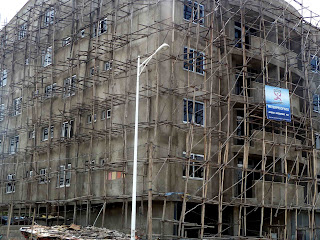I have quickly acquainted myself with the coffee shops and delicious Ethiopian food here. What a change from the instant Nescafe coffee, mashed bananas and goat stew of Uganda! The streets in my neighborhood are filled with small “hole in the wall” cafes. Even the most humble of these coffee sanctuaries can boast large gleaming red or silver espresso machines ready to make your next powerful makiato (coffee and steamed milk). I have found great joy on my weekends taking long excursions through the city with only vague destinations in mind. My sole mission is to walk until I find the next café. I would sit damp from sweat yet relaxed sipping the sweet dark brew for 15 or 20 minutes and then dive back into the smog and bustle to see what I could see!
Coffee has a strong tradition in Ethiopia but in an authentic coffee shop they tend to drink their java in supercharged doses of 4 to 6 ounces and sweet enough to make your teeth hurt. Only the influence of the Italians has lead to the addition of espresso machines and steamed milk to the mixture. The traditional method of making coffee is to grind up the beans using a wooden mortar and a wood or metal pestal. The grounds are placed into an ornamental, narrow necked wooden carafe with the boiling water. The carafe has a slender spout that, due to the narrow necked design, pours the steeped coffee while retaining the grounds. Yes, I can talk about coffee for hours on end but I should give due credit to the food as well!
Currently it is the lent fasting season which eliminates the eating of meat for the 40 days leading up to Easter and the menus at the local restaurants honor this piety in delicious ways. Vegetarian dishes are prepared and served in small quantities. There are 8-12 veggie dishes per plate each having its own unique appearance and flavor and served on large round pieces of fresh injera bread. The meal is aptly named beyayeneto (pronounced bay-ann-o-too) , meaning a variety of foods. Many of the dishes are made from lentils accompanying marinated beets, potatoes and carrots, hot chili peppers, and an assortment of other vegetable delights. It is always prepared fresh and on top of a large round pancake of injera bread, usually about two feet in diameter.
Injera is one of the major staples of the Ethiopian diet. The consistency of injera is that of a soft spongy bread. It is fermented for two days after the watery-like dough has been prepared. It is made from a highly diverse and resilient grain crop known as tef. When I mentioned to a co-worker of mine that I had eaten injera in restaurants in Uganda and Ethiopia he merely scoffed at me. He stated that in most restaurants outside of Ethiopia injera is made from wheat flour and should by no means be considered authentic Ethiopian fare. After the fermentation is complete it is poured onto a large hot pan and cooked like a pancake. The slightly tangy sourness of the injera sets off the flavors of the vegetarian smorgasbord wonderfully. From the moment I arrived I have not gone a day without eating some of this excellent local cuisine.










